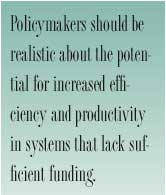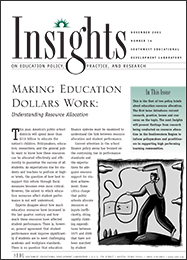Issues for State Policymakers
Policymakers will have various reasons for wanting to examine costs and better understand school spending patterns. They may want to appropriate additional revenue for education but only if that revenue will improve certain educational outcomes. Alternatively, a state may experience a revenue shortfall, and policymakers may need assistance in reallocating resources to maintain (or even improve) outcomes in an environment of fiscal constraints. Policymakers may need to respond to constituents who perceive inefficiency and waste in public education, in which case they will need to make resource allocation decisions that address constituent concerns without jeopardizing learning outcomes for students.
Conflicting or inconclusive research findings on the connection between resources and student performance should not lead educators and policymakers to conclude that little can be done to make resource allocation more effective. Experts who study school finance believe that resource allocation decisions can be improved when desired outcomes are articulated and both the costs and benefits associated with reaching higher standards are understood and measured.
As discussed in the previous section, a number of tools are available to policymakers and policy analysts to better inform school finance decision-making. Knowledge gained through an examination of costs and spending will provide the basis for sound decisions. Policymakers also will benefit from an understanding of state and local needs and strengths and from a clear plan for improving student performance. Examples of some of the concerns policymakers will face when considering school resource allocation include: educational costs, information reporting systems, incrementalism, general education program funding, change processes, and community participation.
Educational costs. Policymakers in many states expect students to meet higher standards, including taking more challenging courses and graduating from advanced programs of study. Each state should examine its school finance system to determine if the way resources are allocated to districts will permit schools and districts to achieve their goals. Policymakers should seek answers to questions like these: What does it cost for the average student to meet higher performance standards, and are these resources provided to all districts? What additional costs are associated with helping students with learning disabilities or students who do not speak English as a first language? What additional costs are incurred by small, rural school districts as they strive to meet performance standards, and does the finance system provide those additional funds? Related issues for policymakers are the accurate identification of the cost differences among different regions and the use of this information to adjust resource allocation. A thorough understanding of educational costs will help policymakers decide how best to deploy state resources. Policymakers should be realistic about the potential for increased efficiency and productivity in systems that lack sufficient funding. 
Information reporting systems. The quality of the state school finance reporting system is another issue that will influence attempts to allocate resources more effectively. As policymakers and their staff members undertake resource allocation studies, they may find inadequacies in the financial reporting system that make it difficult to link student performance to allocated resources. For example, most state reporting systems identify revenue sources and expenditure functions at the school district level but do not provide a link between resources and classrooms or student performance. Ideally, information should track back to the classroom to allow analysts to associate performance with resources. Another inadequacy of some data systems is the lack of expenditure information for specific instructional programs (e.g., elementary reading, bilingual education, compensatory education). If the data are not of sufficient quality and detail to answer resource allocation policy questions, improvements in the data system are needed.
 In cases where data elements are accurate, current, and sufficiently specific, reports and illustrations of revenue streams, expenditure patterns, and student performance measures should convey information in formats that are useful and accessible to policymakers, parents, educators, and others involved in the decision-making process. In many states, policymakers and other stakeholders have access to raw data but lack information in a usable and easily understood format to explore program costs and student performance by program. Without good information, policymakers will have difficulty determining which initiatives to pursue, parents will not understand the way that funds are allocated, and educators will not have evidence of the efficiency of services and programs. Information gained as the result of research conducted within the state should be readily available to these audiences. Experimental studies of new programs and initiatives can offer guidance about program effectiveness as well as costs. That, in turn, can guide policy and practice.
In cases where data elements are accurate, current, and sufficiently specific, reports and illustrations of revenue streams, expenditure patterns, and student performance measures should convey information in formats that are useful and accessible to policymakers, parents, educators, and others involved in the decision-making process. In many states, policymakers and other stakeholders have access to raw data but lack information in a usable and easily understood format to explore program costs and student performance by program. Without good information, policymakers will have difficulty determining which initiatives to pursue, parents will not understand the way that funds are allocated, and educators will not have evidence of the efficiency of services and programs. Information gained as the result of research conducted within the state should be readily available to these audiences. Experimental studies of new programs and initiatives can offer guidance about program effectiveness as well as costs. That, in turn, can guide policy and practice.
Incrementalism. Undertaking significant, statewide reform is another challenge for policymakers seeking to improve resource allocation. It is difficult to muster support at the state and local levels for education reform that involves dramatic shifts in funding, services and programs, or administrative structures. Instead, many states provide incremental resource increases each year for all types of programs, activities, and functions without regard to their relative effectiveness in achieving state goals. Incrementalism can dilute the potential benefits of powerful strategies that require targeted infusions of resources. In addition, relying on steady, periodic increases in revenues causes educational systems to find security in long-standing formulas that calculate and distribute resources. Neither approach-across-the- board incremental increases nor the use of time-tested formulas - is likely to yield resources that will result in significant learning improvements for all students.
General education program funding. Rothstein recommends that policymakers examine the issue of allocating appropriate funding for the general education program. Policymakers may need to analyze whether across-the-board revenue increases are actually going to the general program that serves the most students or whether they are used primarily to fund special programs. Policymakers may want to discuss whether to encourage the flow of additional resources (and assignment of more students) to the general instructional program and away from special programs and add-on services. Because basic requirements for student performance, such as test performance standards, rest almost entirely within the general program, appropriate resource allocation for core instruction in general education settings should be a priority.
Change processes. Organizational change involving funding and services can be disruptive and unsettling. Without constituent input and support for proposed changes, policymakers risk dissatisfaction and even censure. Resource allocation policy changes can be especially alarming to constituents who find their jobs or their income levels changed by shifts in funding. For example, more than 80 percent of education resources go toward salaries, wages, and benefits for people who work in school districts; some new approaches to resource allocation may likely threaten some district employment and job assignments. Policymakers should seek ways to include the perspectives and input of all stakeholders to ease the challenges associated with change.
Community participation. Parents and other members of the public approach education issues from the perspective of personal goals and expectations rather than statewide performance results. Their support also is critical to successful policymaking and the implementation of new fiscal structures. Parents and the public-at-large need clear information to understand current education resource needs and challenges. In turn, they can be a source of information to policymakers on the needs of individual students and local schools. Recently, states have begun to provide accountability reports and school report cards to help stakeholders understand student performance. States also should develop information vehicles that will help convey a deeper understanding of resource allocation and of any policy changes that might affect their children's education. The public needs opportunities to become involved in exploring the options that may improve the system for all students, and open communication will increase their effectiveness in that endeavor.
Next Page: In Closing / Additional Information Resources

